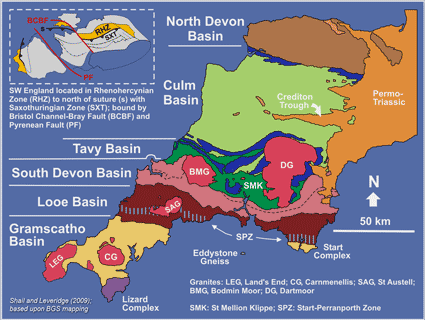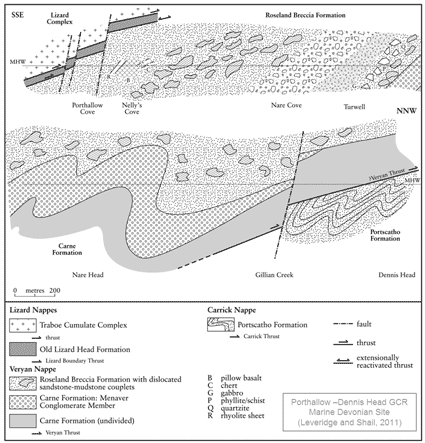Profile
Prof Robin Shail
SW England Devonian
The Devonian System was proposed by Sedgwick and Murchison in 1839 on the basis of the distinctive marine fauna in SW England; 'Devonian' is retained but all its component stages are defined in mainland Europe. Studies of SW England regional geological evolution have been hindered by considerable lithostratigraphical and structural complexity. A 30-year re-mapping programme by the British Geological Survey has demonstrated how the Upper Palaeozoic stratigraphy relates to rifting, passive margin development and subsequent Variscan convergence.
Devonian successions in the Rhenohercynian Zone of SW England
The Devonian successions of SW England record the development, and subsequent closure, of a predominantly marine basin that was either marginal to, or succeeded, the Rheic Ocean (see Variscan Tectonics). The Devonian (and Carboniferous) stratigraphy and geological evolution are very similar to the Rhenohercynian Zone of the Variscan Orogen further east (France, Belgium, Germany) and the South Portuguese Zone. Overviews of Devonian basin development and lithostratigraphy are provided by Leveridge and Shail (2011a) and the broader Upper Palaeozoic tectonic evolution by Shail and Leveridge (2009).
Gramscatho Basin / Lizard Complex (Cornwall)
The Gramscatho Basin and Lizard Complex (see figure above) preserve partial evidence for the distal (highly attenuated + ocean floor) segment of the SW England Rhenohercynian passive margin. They also record convergent margin sedimentation, magmatism and metamorphism during the closure of this basin during (or possibly after) Rheic Ocean closure (Leveridge and Shail (2011b). Aspects of the lithostratigraphy of the Gramscatho and Looe basins on the north coast of Cornwall are described by Shail (1989) and Hollick et al. (2006). A view on the internal organisation of tectonostratigraphical units within the Lizard Complex is presented by Power et al. (1996)
Looe Basin felsic magmatism
Early Devonian syn-rift felsic magmatism is relatively rare but well known from the eastern Looe Basin in Devon. Penfound-Marks and Shail (2016) provide details of previously undescribed Early Devonian felsic igneous rocks, that they termed the Hoblyn’s Cove Felsite, that crop out in the structurally complex coastal section through the Start-Perranporth Zone between Ligger Point and Holywell Bay in Cornwall.
Lithogeochemistry of Devonian successions
A preliminary assessment of the baseline whole rock lithogeochemistry of Devonian successions in Cornwall, in areas remote from mineralisation, is provided by Scott et al. (2003).


